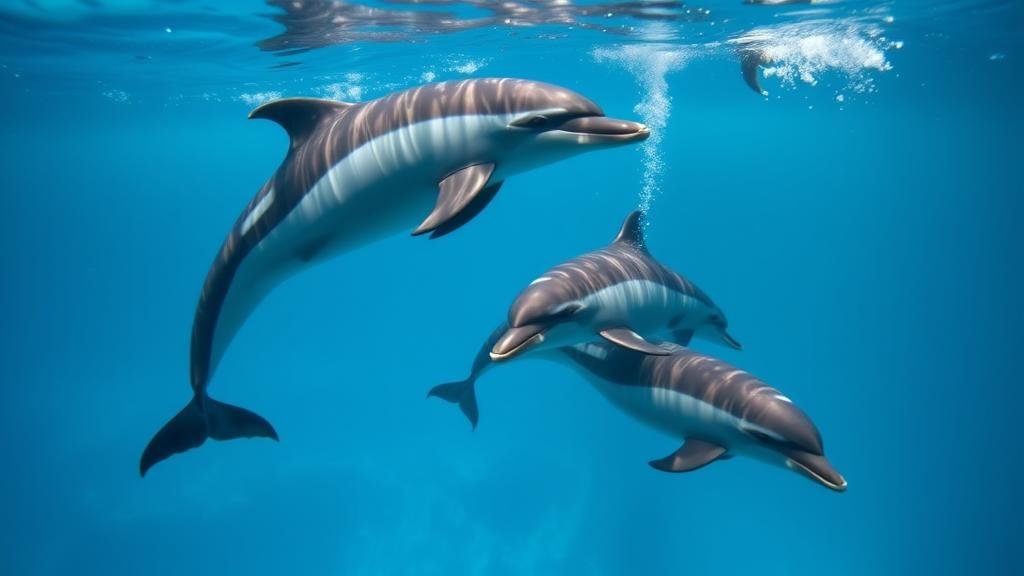Documenting the underwater world of spinner dolphins in tropical oceans.
Documenting the Underwater World of Spinner Dolphins in Tropical Oceans
The underwater world of spinner dolphins (Stenella longirostris) is a vibrant tapestry of marine life, rich with complex ecosystems thriving in tropical oceans. This article explores the fascinating behaviors, habitats, and conservation efforts related to these remarkable creatures, offering insights into their significance within marine biodiversity.
Understanding Spinner Dolphins
Spinner dolphins are known for their acrobatic displays, often leaping out of the water and spinning mid-air, from which they derive their name. They inhabit warm, tropical waters, predominantly found in regions such as the Pacific Ocean and the Indian Ocean. Species of spinner dolphins typically range from 1.5 to 2.5 meters in length and can weigh up to 75 kilograms.
These dolphins are highly social animals, often found in pods that can number in the hundreds. Their social structure is complex, featuring strong bonds among individuals, which aids in cooperative behaviors during hunting and social interactions.
The Habitats of Spinner Dolphins
Spinner dolphins thrive in a variety of marine environments, including coastal areas, oceanic islands, and offshore waters. They prefer shallow waters, often residing in bays or lagoons that offer protection from strong currents and predators. For example, areas around the Hawaiian Islands serve as critical habitats due to the abundance of food sources such as small fish and squid.
Seasonal migrations also characterize spinner dolphins, with notable populations exhibiting cyclical patterns that correlate with prey availability and environmental conditions. This adaptability highlights their ecological significance and the need for ongoing research regarding their habitat preferences.
Documenting Interaction and Behavior
Documenting spinner dolphins in their natural habitat involves both observation and technology. Researchers often rely on underwater photography and video to capture their behaviors and interactions. Notably, studies have revealed intricate communication techniques, including clicks, whistles, and body movements.
For example, a study conducted in 2019 around the Big Island of Hawaii demonstrated that spinner dolphins employ specific vocalizations to coordinate hunting strategies within their pods, ensuring high-efficiency foraging. By utilizing hydrophone technology, scientists are able to analyze these acoustic signals, furthering our understanding of marine mammal communication.
Conservation Efforts and Challenges
Despite their charismatic nature, spinner dolphins face significant threats due to human activities. Overfishing, habitat degradation, and the impacts of climate change pose critical challenges to their populations. According to the International Whaling Commission, spinner dolphin populations have been declining, with estimates suggesting a drop of nearly 50% in some regions over the past three decades.
Efforts to conserve these dolphins are essential. Organizations like the Oceanic Society and the Dolphin Project are actively engaged in protecting spinner dolphin habitats and advocating for sustainable fishing practices. The establishment of marine protected areas (MPAs) is crucial, as it allows these ecosystems to recover from overexploitation and provides a safe haven for spinner dolphins and other marine wildlife.
The Importance of Raising Awareness
Documenting the lives of spinner dolphins not only enriches our understanding of marine biology but also emphasizes the need for conservation. Public awareness initiatives help engage communities and promote sustainable practices. Educational programs focusing on marine life, such as those implemented in local schools surrounding coastal areas, can inspire future generations to protect ocean biodiversity.
- Engaging community-driven conservation projects.
- Utilizing social media platforms to share research findings and experiences.
Conclusion
Documenting the underwater world of spinner dolphins is an ongoing journey that reveals the splendor and intricacy of marine life. Through rigorous research and conservation efforts, we can ensure these extraordinary creatures continue to thrive in their natural habitats. Equally important is our collective responsibility to foster a deeper appreciation for the ocean and its inhabitants, ultimately striving for a balanced coexistence with nature.
As we continue to explore this enchanting underwater realm, it is imperative to advocate for sound environmental practices, support local conservation initiatives, and engage in the conservation dialogue. This will help secure a sustainable future for spinner dolphins and the rich ecosystems they inhabit.



